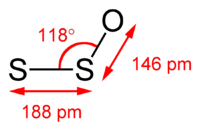
Photo from wikipedia
The aqueous solutions of different stability containing silver sulfide (Ag2S) nanoparticles are studied. The stable, transparent, and turbid solutions have been subjected to daylight for 7 months, to ultraviolet and… Click to show full abstract
The aqueous solutions of different stability containing silver sulfide (Ag2S) nanoparticles are studied. The stable, transparent, and turbid solutions have been subjected to daylight for 7 months, to ultraviolet and laser irradiation, as well as to an electron beam. Solar radiation is found to favor the Ag2S reduction to Ag and/or the formation of Ag2S/Ag hybrid nanoparticles in the solution. At a high amount of hybrid nanoparticles, the exciton–plasmon interaction causes asymmetry in the absorption spectra. The exposure of Ag2S particles precipitated from the solution with the electron beam leads to the reversible growth of Ag threads. The possible exciton–plasmon interplay mechanisms in Ag2S/Ag hybrid nanoparticles are considered. The physical mechanisms of the changing Ag2S stoichiometry, the formation of metallic Ag and Ag2S/Ag hybrid nanoparticles are the generation of hot carriers and the energy transfer (exciton–plasmon interaction) in a metal–semiconductor hybrid nanosystem are elucidated, as well.
Journal Title: Physics of the Solid State
Year Published: 2017
Link to full text (if available)
Share on Social Media: Sign Up to like & get
recommendations!